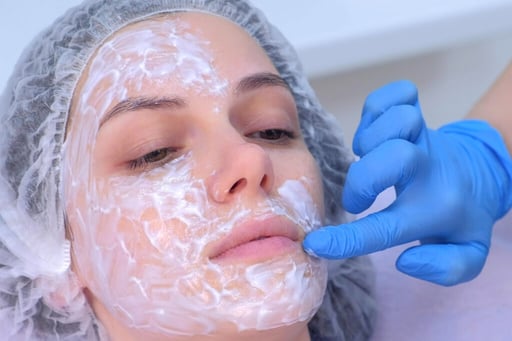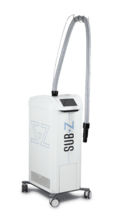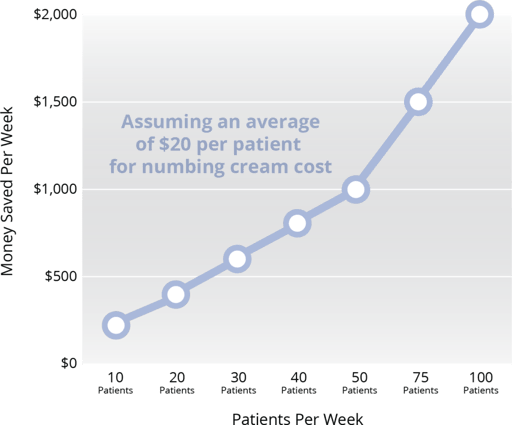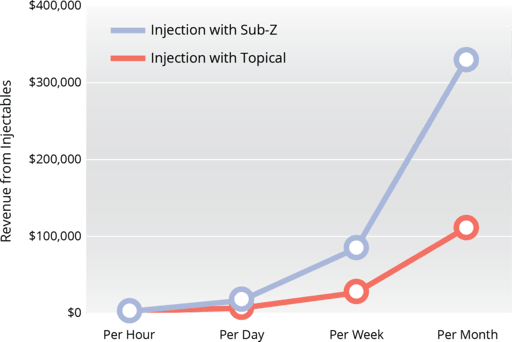The Business of Numbing: Why traditional approaches could be costing you
Fear of needles, injections, or other procedure-related pain is the number one barrier for patients seeking aesthetic treatments, according to a global study. Gone are the days of no pain, no gain; aesthetic consumers are more knowledgeable than ever and have high expectations of their aesthetic journey both in terms of treatment outcomes and a comfortable experience, and they will seek out the procedures or providers that can offer both.
While most providers reach for topical numbing to provide comfort, this approach could be costing you in the short and long run. A new cryo-solution, Sub-Z, has begun to make injectors and laser specialists reconsider how they go about numbing.
First, let’s break down all the options out there.
Do I Even Need a Numbing Program?
While technological advances have enabled providers to deliver remarkable results with non-invasive treatments, many of the in-demand treatments still require a numbing agent.
Popular treatments that are often performed in conjunction with a numbing program include injectables, radiofrequency (RF) microneedling, CO2 resurfacing, tattoo removal, ultrasound therapies, and other energy-based treatments. Treatments like thread lifts, PRP injections for hair regrowth, and some chemical peels also employ numbing for comfort. As a result, a numbing protocol is unavoidable for any aesthetic practice offering an array of treatments to meet patient demands.
“The Traditional”: Topical Numbing
Topical, local anesthetic remains the most popular method for numbing in aesthetic practices because of its easy application. It’s typically administered by applying a topical cream or ointment, but some experienced injectors may inject the lidocaine for a more pronounced anesthetic effect (see below).
Lidocaine and benzocaine are considered the most efficacious of numbing agents, and the two are often combined into compound numbing agents. The most common formulation is called BLT, which contains a combination of benzocaine 20%, lidocaine 6%, and tetracaine 4%. Another well-known compound EMLA pairs lidocaine with prilocaine.
While topical numbing is easy to apply and well-understood by patients, there are several downsides a practice should consider.
Cost: The cost of numbing cream will vary depending on which topical is used, how much is used, and for which procedure, but it’s safe to budget an average of $20 per patient per treatment. It doesn’t seem like a lot on its own but added up, it can cut into profit margins for a busy or budget-conscious practice.
Time: These topical anesthetics take 15-20 minutes on average to activate. The savvy provider will use this waiting time to attend to other patients or needs in the practice, but there are two big downsides. First, the patient must wait in the chair as they numb, which is not a good use of their time nor an optimal experience. Second, the patient is taking up a treatment room for that period of time, which reduces the rate at which you can turnover that room and consequently its revenue-generating opportunity.
Patient Experience: Although effective, topical numbing lidocaine can have dangerous side effects and is not tolerable for every patient. While rare, some side effects that can happen include blistering, irritation, hives, joint pain, fever, swelling on the face, and trouble breathing. Separately, some patients are allergic to popular topical anesthetics, while others simply do not like the feeling of topical numbing cream as it can be sticky and messy.
Availability: This year, many providers felt the pain of the nationwide lidocaine shortage, which was driven by increasing demand across medical and aesthetics. It led to cancelled treatments and reduced revenue for many practices. While we cannot predict when shortages will occur (or re-occur), with many practices depending on a single substance for numbing, and as the aesthetic industry continues to expand, any prepared practice may want to have an alternative so they’re not scrambling for resources in the future.

The Alternatives: Anesthetic Injections, Vibrations, and Cooling
More and more practices have embraced alternatives to topical anesthetics due to the abovementioned downsides and exacerbated by the lidocaine shortage. Below, we break down the three most popular alternatives to topical anesthetics.
Localized Anesthetic Injection/Nerve Blocking
First, it’s important to note that this technique still requires lidocaine and thus does not circumvent the lidocaine shortage. A localized anesthetic injection is an advanced technique where lidocaine is injected to perform nerve blocking. It’s advanced as it requires injections into localized nerve regions and an understanding of the anatomy of nerves.
Nerve blocking is the most extreme form of pain prevention, so the patient will be the most comfortable. Nerve blocking is most often used for treatments such as threading, fillers, and more aggressive laser treatments. It’s not possible to achieve nerve blocking with a topical anesthetic, so injection is the only method.
While nerve blocking via anesthetic injection is effective, for patients who already have trepidations about treatments, especially injectable treatments, they may not opt for an additional injection. The other limitation of nerve blocking via injection is that it’s not an option available to all providers, depending on their level of training, experience, and confidence.
Gate Control/Vibration Distraction
Vibration distraction – specifically for facial injections – has become a popular alternative for enhancing the patient experience without prescription medications.
The reasoning behind vibration distraction lies in the “Gate Theory of Pain.” According to the Gate Theory, the sensory neurons carrying pain signals from the skin and the neurons that carry vibratory sensations from the skin use the same nerve pathway to the brain. Therefore, delivering vibratory sensations helps block the messages sent by the neurons that sensed pain.
Through a vibration tool used on the face during the injection procedure, the vibrations may trick the body into feeling less pain sensations. The benefits of these vibration tools are that they’re inexpensive, widely available, and relatively easy to use.
A somewhat new methodology, some small studies have been done that demonstrate the positive effect of vibration devices on pain during injectable treatments. It’s important to note that the vibration technique does not provide an analgesic effect – it merely distracts the patient but does not provide anesthesia or pain relief.
Ice/Cryo Cooling
Ice pack application has commonly been used to cool and numb injection sites. Using an ice pack also has the added benefit in aiding in reduction of swelling and bruising post-procedure. While elementary, it certainly works!
Today, the proliferation of cryo cooling technology has taken the ice pack to the next level. You may be familiar with cryo facials or cryo chambers used for wellness purposes, but cryo cooling technology can also serve as a numbing tool for aesthetic treatments.
One of the major benefits of cryo cooling is it saves the provider’s time. Providing comfort or numbing via cryo cooling can take seconds, drastically cutting down on the 10-20+ minutes required for topical numbing. This allows providers to cut down on room time per treatment and book more appointments. Another major benefit is that cryo cooling helps mitigate patient downtime by reducing redness, swelling, and bruising – something that no other numbing program does!
The downside of cryo cooling is that you do need to invest in equipment, especially if you’re looking for an efficient & effective cryo device. Some devices may require consumables as well, as nitrogen & CO2 cartridges and tanks can become costly. These gasses may also present environmental concerns and require special accommodations.
Combination Numbing Programs For many procedures, some providers will opt for combining different numbing methods to achieve the desired effect. For example, you may apply an ice pack to numb initially then perform an analgesic injection for a thread lift treatment. The vibration technique mentioned earlier is often combined with topical numbing for more effective pain prevention.
Cryo Cooling with Sub-Z: The Coolest New Kid on the Block

Sub-Z is a new class of cryo cooling technology created by Zimmer, the global leader in cryo. Sub-Z effectively numbs tissue in less than 15 seconds and can create nerve blocking in less than 20 seconds. With 3 nozzle sizes and 9 fan speeds, providers can target specific therapeutic temperatures depending on the treatment performed. As the most powerful system on the market, Sub-Z cools 3 times faster than other cryo devices.
Another benefit of Sub-Z? It’s completely consumable-free. Sub-Z is electro-powered and tank-free, meaning no need for dangerous or expensive gas tanks. Save money on consumables & numbing cream, and generate more revenue by cutting down room time and performing more treatments per day.
The graphs below provide insight into the dollars a cryo solution can put back in your pocket. If we assume a $20 cost per patient for topical numbing, depending on patient demand, the weekly savings can hit $2,000 and beyond. That’s over $100,000 per year that can be put to new equipment and investments to expand your business. In addition, eliminating the need to occupy rooms for pre-procedure numbing could have a substantial impact on the revenue your treatment rooms generate. With a numbing protocol that takes seconds instead of 15-20 (sometimes even 30) minutes, you could block rooms on the half hour instead of the hour and see twice the number of patients.
Contact us to learn more about how Sub-Z can enhance patient experience & improve profit at your practice.
SAVE ON NUMBING CREAM COST

CUT DOWN ROOM TIME & DOUBLE YOUR REVENUE*


